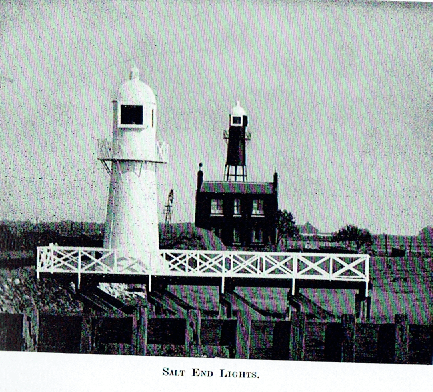
Today’s picture is a photo reproduced in the 1939 book (s.p.b.s) showing the high and low lights at Saltend. Described as being sited just west of the mouth of Hedon Haven, I know of no surviving evidence of things shown in the photo. I’m not sure when the chemicals complex currently at Saltend began to be developed but, presumably, the above photo pre-dates it. The notes state that the two aids to navigation shown in the photo were built in 1870 as was the caretaker’s cottage shown, a far more substantial property than those built alongside the earlier lighthouses. Both low and high light had a skeleton of wrought iron and a covering of sheet metal. By 1926 the light apparatus in both had been designed to be automatic, electrically operated and unattended as both lights were controlled by a clockwork mechanism which had to be wound once a month. No resident keeper was henceforth needed so the house shown in the photo was rented out after 1926.
The white structure alongside the low light supported rails along which the low light could be moved if the deep-water channel moved. Electricity for the automatic system was supplied by Hull Corporation from their coal-fired electricity power station.
Thus, the high light and low light at Saltend and at Thorngumbald (s.p.b.s) were very similar and provided more flexible aids to navigation than did the brick-built lighthouse at Paull which was soon decommissioned and to become a private house up to the present day, although I think now empty.
One question that needs to be answered is why these expensive shore-line structures were concentrated in the middle reaches of the Humber. The answer is simply that they served to direct shipping to and from the port of Hull which had become far and away the major port on the Estuary.
(to be continued).